
Can you see owls in Oklahoma? You sure can! In Oklahoma, woodlands echo with the loud barking calls of Barred Owls throughout the state. You might also hear the whinnying whistles of Eastern Screech-Owls and the deep, mysterious hoots of Great Horned Owls.
Look for owls in Oklahoma, and you’ll find them! How many owls live in Oklahoma? Which owls are rare, and which are common?
Are Owls Common In Oklahoma?
In order to get a stronger sense in Oklahoma’s owl populations, we dived into eBird data. As it turns out, out of the nine birds spotted in the last year, six are common, other three are more scattered and presumably just passing through.
Let’s take a closer look!
Barred Owl
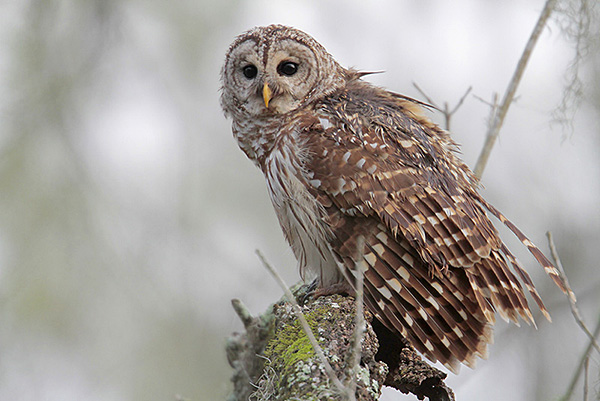
Photograph © Greg Lavaty.
- Range: A permanent resident in most forested areas in Canada, parts of some Pacific Northwestern states, and most of the eastern USA.
- Length: 21 inches
- Wingspan: 42 inches
- Call: Makes loud hooting and caterwalling sounds, “Who cooks for you?! Who cooks for youaaaal!”
The Barred Owl is a medium to large owl with a round head and a narrow black border on its pale gray face. As their name hints, these owls have heavily barred plumage.
Barred Owls live in deciduous and coniferous forest and woodlands
Key Identifications:
- Big owl with a round head that has white marks on dark brown upperparts, and dark brown streaks on pale underparts.
- Perches and swoops through wooded areas at night but can also be active in the day.
- Nests in tree cavities and in abandoned nests of crows and hawks.
- Catches a wide variety of small animals.
Great Horned Owl
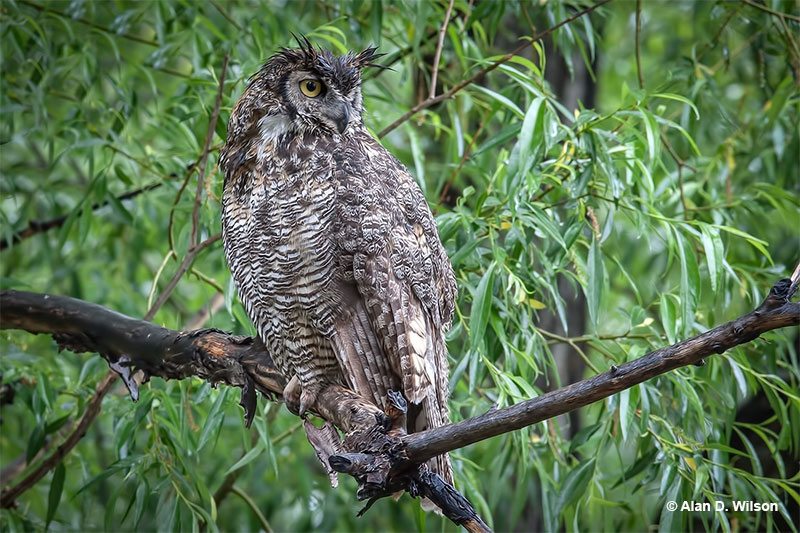
- Range: Permanent resident in much of Alaska, Canada, and the USA.
- Length: 22 inches
- Wingspan: 44 inches
- Call: Makes a low, gruff, “hooo, hoo hoo hoo hoooo”.
The Great Horned Owl is a big, bulky owl with big ear tufts and a black beak. It is mottled gray and brown, has a rufous or gray face, and fine black barring on its underparts. This owl also has a white throat and some dark marks on its breast.
Males and female Great Horned Owls look the same but females are larger.
This nocturnal owl species lives in every possible habitat, including urban areas. They are strong contenders for the title of the most common owl in Oklahoma!
Key Identifications:
- Big, bulky brown or gray owl with ear tufts and fine barring on its underparts.
- Nests in old stick nests of other large birds, on ledges, and in other situations.
- Watches from a perch or glides over open habitats at night, to catch mammals and some birds on the ground.
Eastern Screech-Owl
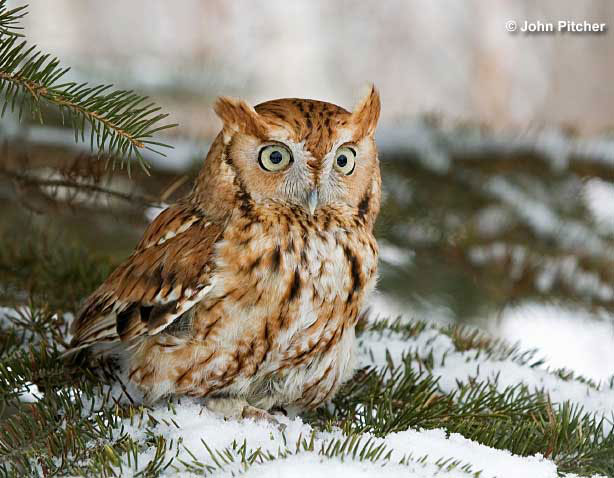
- Range: Permanent resident in parts of southeastern Canada, and in much of the eastern USA.
- Length: 8.5 inches
- Wingspan: 20 inches
- Call: Makes a rather high-pitched, descending whinny call, and a tremulous, vibrating call on the same pitch, “wududududududududududu”.
The Eastern Screech Owl is a small owl with ear tufts. It can be reddish, brown, or mostly gray, has “V”-shaped pale eyebrows, and some black on the edge of its face. It is also mottled above with some white spotting, and has pale underparts with dark barring and streaks.
Males and females look alike but females are a bit larger. This species also has yellow eyes, a pale yellow-gray beak, and some white bands on its broad tail.
Eastern Screech-Owls flap and glide on long, broad wings.
During the day, this owl hides in holes, or in dense vegetation. Eastern Screech Owls are fairly common throughout the year.
Key Identifications:
- Small owl with ear tufts and mottled brown or gray plumage that lives east of the Rocky Mountains.
- Lives in a variety of wooded and park-like habitats.
- Nests in tree cavities and nest boxes.
- Swoops down to the ground catch a variety of small animals at night.
Burrowing Owl
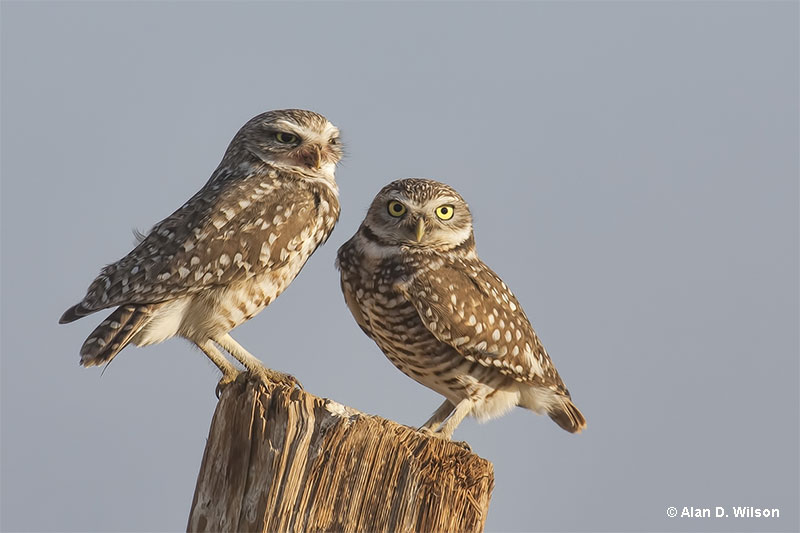
© Alan D. Wilson
- Range: Summer resident in central-southern Canada, the Great Plains, and much of the western USA. Permanent resident in California, Texas, and Florida.
- Length: 9.5 inches
- Wingspan: 21 inches
- Call: Makes a raspy, chattering call, “rap, rip,rip,rip,rip”, and a quail-like, “whup waaah!”.
The Burrowing Owl is a small, long-legged owl with a white throat and white eyebrows. It has a round head, is dark brown with white spots above, and has pale underparts with dark barring.
Males and females look alike although females are a bit larger. Young birds are uniform dark brown and buff.
Adult Burrowing Owls in Florida are more heavily marked below than western birds but juveniles from Florida are paler.
These little owls only come to Oklahoma for the breeding season.
Key Identifications:
- Small, long-legged owl with a round head, and some brown barring on pale underparts.
- Lives in grasslands and other wide-open habitats.
- Nests in burrows made by prairie dogs and other animals although birds in Florida make their own burrows.
- Catch small animals on the ground at any time of the day or night.
Short-eared Owl
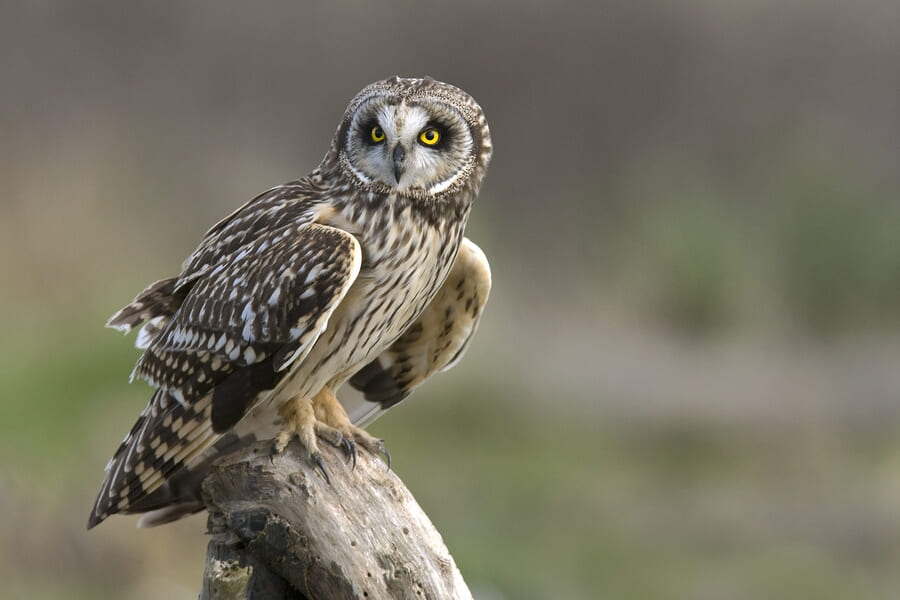
- Range: Summer resident in Alaska, Canada, and the western and central USA. Northern birds migrate to the USA, south to California and Texas.
- Length: 15 inches
- Wingspan: 38 inches
- Call: Makes a hoarse, raspy, cat-like call, “rehw”.
The Short-eared Owl is a medium-sized, pale brown owl with dark eye patches on a pale face. They have a dark breast and streaks on pale underparts. This species has long wings with buff wing patches.
Both sexes look similar but females are a bit larger and usually darker and buffier.
This owl is active day and night in open fields.
Key Identifications:
- Medium-sized pale brown and buffy owl with very short ear tufts.
- Dark eye patches on a pale face and long wings with buff patches near the wingtips.
- Nests on the ground in dense vegetation.
- Glides over open fields to catch small animals on the ground.
Barn Owl
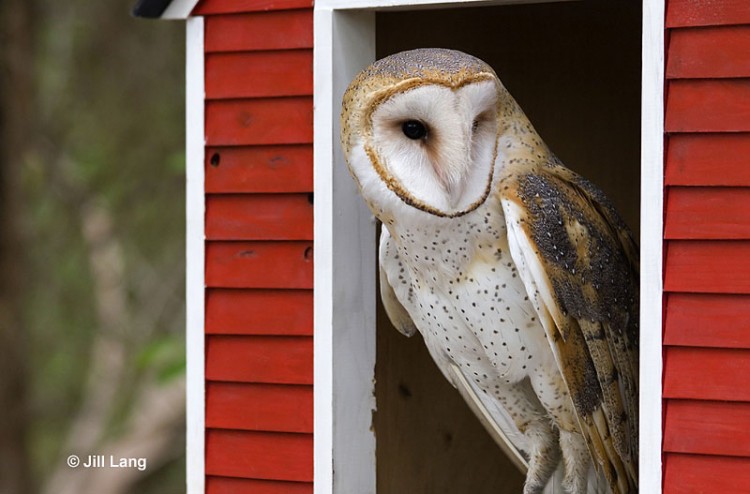
- Range: In Canada, occurs mostly in southwestern British Columbia. In the USA, they live in many areas but are absent from mountains and cold, northern regions. They range north to Washington, Nebraska, Iowa, and New York.
- Length: 16 inches
- Wingspan: 42 inches
- Call: A shrill, loud, hissing “shriiiiii!”
The Barn Owl is a medium to large, pale owl with golden tan and gray upperparts, and white underparts. It has a distinctive, white, heart-shaped face.
Both sexes are alike but females are a bit larger than males and have buff on their chest.
In flight, Barn Owls look like a large, pale, moth-like bird with a big, rounded head.
Barn Owls prefer open and urban areas. They stay in Oklahoma year-round, but they are not spotted to often.
Key Identifications:
- Large pale owl with a heart-shaped face.
- Glides and flutters over fields and other open areas at night.
- Nests in tree cavities, crevices in church steeples and other structures, and next boxes.
- Preys on rats and other small animals.
Western Screech-Owl (rare)
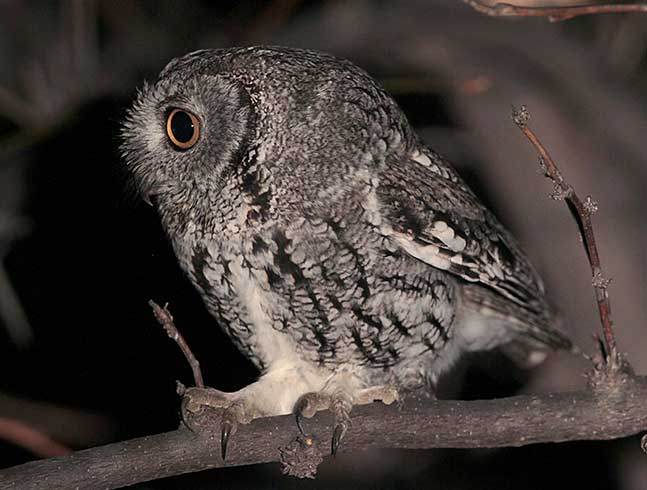
- Range: Permanent resident in British Columbia and the western USA.
- Length: 8.5 inches
- Wingspan: 20 inches
- Call: Has a “bouncing ball” song of short notes, “whup…whup..whu,whu,whu,whu,waa”.
The Western Screech Owl is a small brown or gray owl with ear tufts. It has “V”-shaped pale eyebrows, and some black on the edge of its face. This owl also has mottled upperparts with some white marks, and pale underparts with dark barring and streaks.
Males and females look similar but females are a bit larger. This species also has broad, rounded wings and a broad tail.
Western Screech Owls are on the rarer side in Oklahoma; they usually keep further west. Even so, they can sometimes be spotted!
Key Identifications:
- Small, brownish or gray owl with ear tufts, a black border on the edge of its face, some dark streaks and markings on its underparts, and some white marks on its shoulder.
- Lives in many wooded and forest habitats.
- Nests in tree cavities and nest boxes.
- Watches from a perch before flying to catch small animals on the ground and from vegetation at night.
Long-eared Owl (rare)
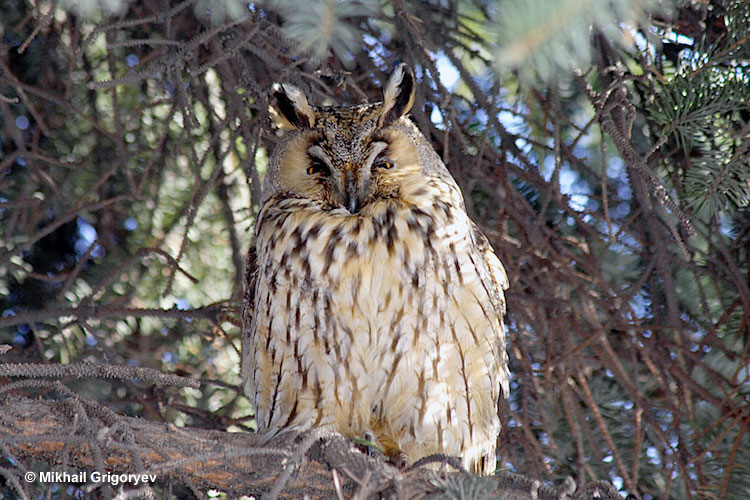
- Range: Migrant in southern Canada, resident and winters in much of the USA. Absent from parts of the Pacific Northwest and southeastern states.
- Length: 15 inches
- Wingspan: 36 inches
- Call: Makes a single, one second long “Hooo!” call at regular intervals.
The Long-eared Owl is a medium-sized, slender owl with long ear tufts. It has an orange face, is mottled gray above, and has dark brown streaks and marks on pale underparts. This owl also has long wings with a rufous patch in its primaries.
Male and female Long-eared Owls look similar but females are larger. This owl species also has yellow eyes, and some pale markings between its eyes and around its dark beak.
This nocturnal owl prefers coniferous woodlands near meadows. They are rare visitors in Oklahoma and usually won’t stay for long.
Key Identifications:
- Medium-sized, slender owl species with long ear tufts, orange on its face, and long wings with an orange-brown patch near the wingtips.
- Occurs in coniferous and mixed forests near meadows, bogs, and other open areas.
- Nests in old crow, magpie, and hawk nests.
- Glides over open habitats near forest at night to catch small animals on the ground.
Northern Saw-whet-Owl (rare)
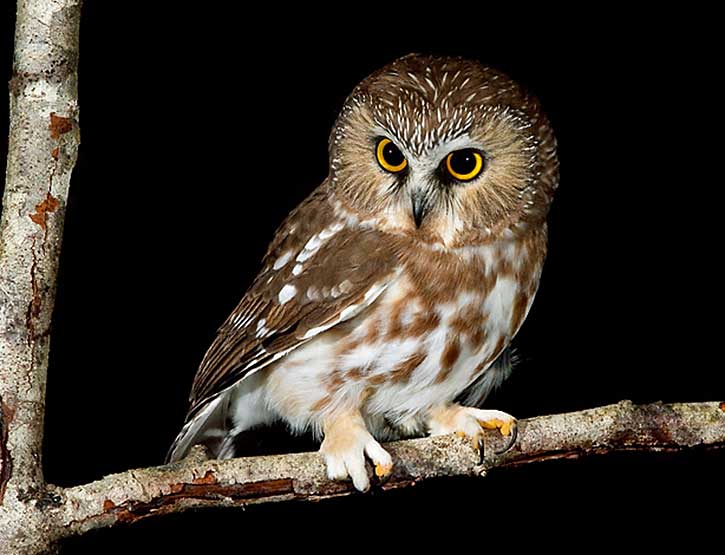
- Range: Lives in coniferous and mixed hardwood forests of Alaska, a large area of Canada, and parts of the northern and western USA.
- Length: 8 inches
- Wingspan: 17 inches
- Call: Makes a repeated tooting whistle call, over and over, “tu, tu, tu, tu, tu, tu, tu, tu, tu”.
The Northern Saw-whet Owl is a small, dark brown owl with a round head and brown streaks on white underparts. It also has some pale streaks on its head, a brown and white face, and some white spotting on its back.
Both sexes look the same but females are a bit larger. This species also has yellow eyes, a dark beak, longish, rounded wings, and a short, broad tail.
This nocturnal owl lives in forested habitats, but they are rare in Oklahoma.
Key Identifications:
- Small, dark brown owl with a round head, broad white eyebrows, and thick dark streaks on pale underparts.
- Occurs in dense coniferous and mixed forest.
- Nests in old woodpecker holes and can use nest boxes.
- Swoops down to catch insects and small animals at night.
Owls in Oklahoma – FAQ’s
Are owls common in Oklahoma?
Yes, owls are common in Oklahoma. Their nocturnal habits can make them hard to see but owls are common birds in the state.
Where do owls live in Oklahoma?
In Oklahoma, owls live in woodlands, open areas, in wooded parks, and other areas with natural habitats.
How do you attract owls in Oklahoma?
You attract owls in Oklahoma by installing screech-owl nest boxes, planting trees, and letting parts of your backyard go wild.
Are owls protected in Oklahoma?
Yes, owls are protected in Oklahoma under the Migratory Bird Treaty Act.
Read next: Birds in Oklahoma | Oklahoma’s State Bird

